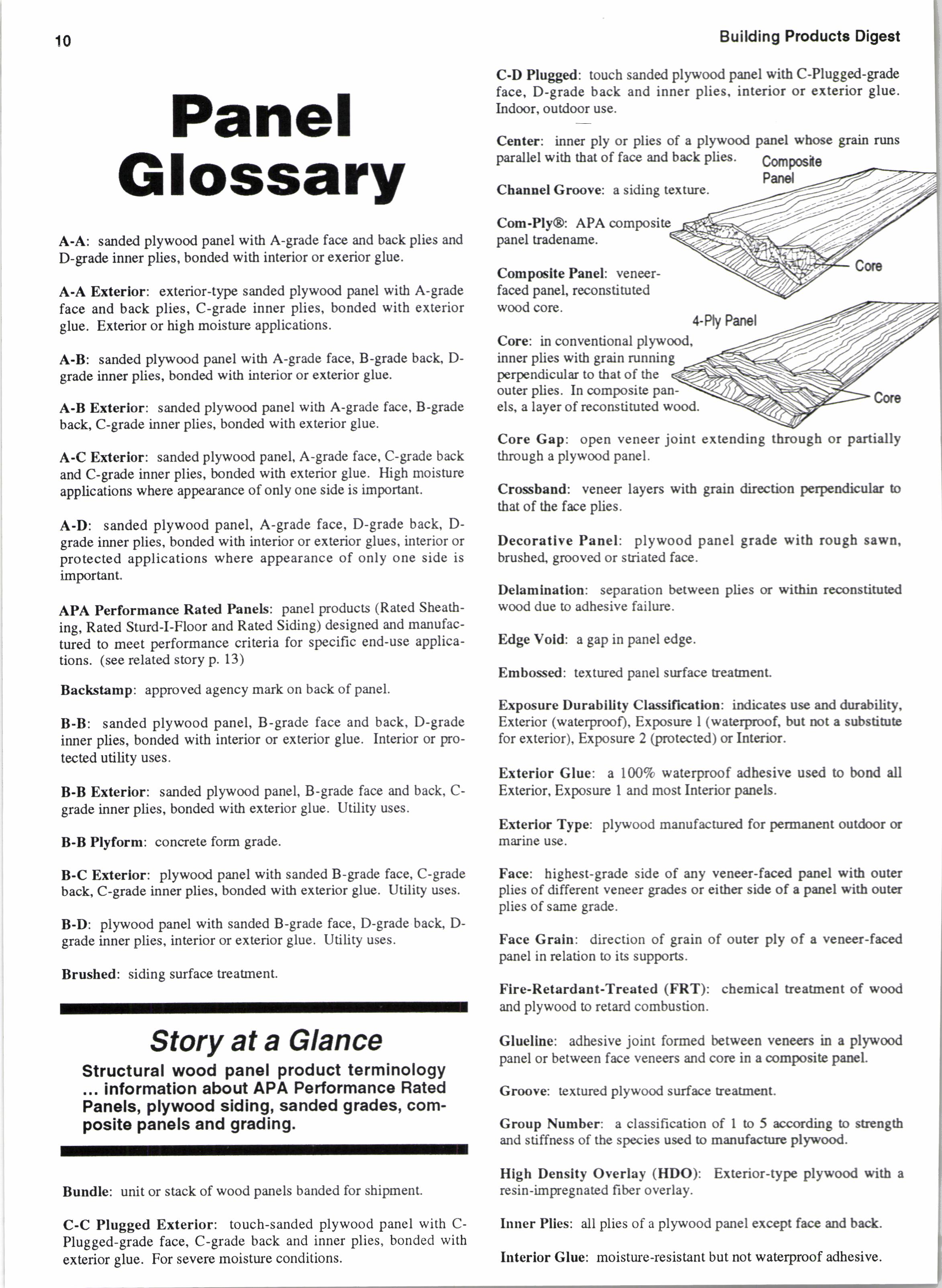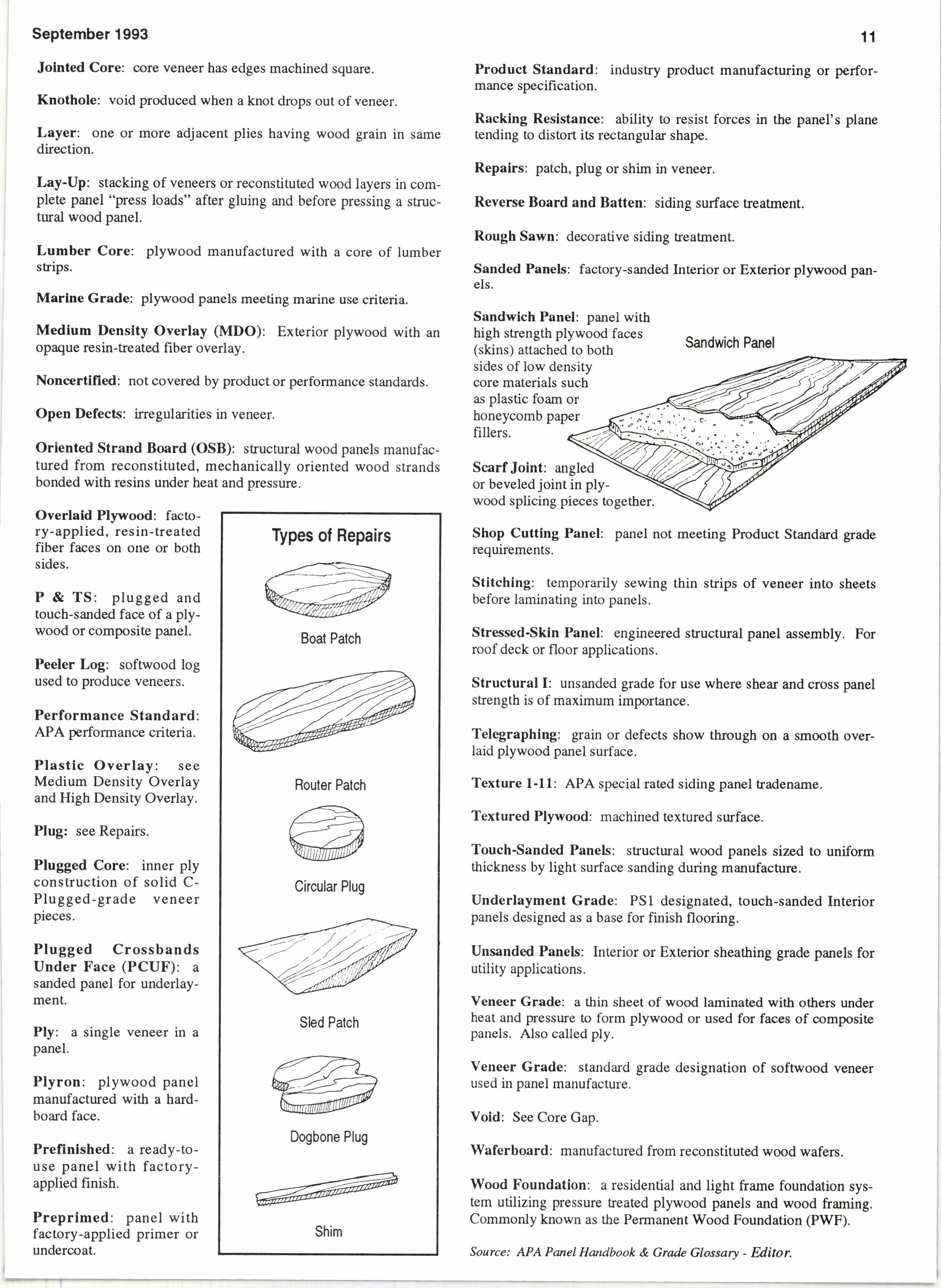
4 minute read
Panel Glossary
A-A: sanded plywood panel witb A-grade face and back plies and D-grade inner plies, bonded with interior or exerior glue.
A-A Exterlor: exterior-type sanded plywood panel witb A-grade face and back plies, C-grade inner plies, bonded witb exterior glue. Exterior or high moisture applications.
A-B: sanded plywood panel witb A-grade face, B-grade back Dgrade inner plies, bonded with interior or exterior glue.
A-B Exterlor: sanded plywood panel with A-grade face, B-grade back, C-grade inner plies, bonded with exterior glue.
A-C Exterior: sanded plywood panel, A-grade face, C-grade back and C-grade inner plies, bonded witb exlerior glue. High moisture applications where appearance of only one side is important.
A-D: sanded plywood panel, A-grade face, D-grade back, Dgrade inner plies, bonded with interior or exterior glues, interior or protected applications where appearance of only one side is important.
APA Performance Rated Panels: panel products (Rated Sheatbing, Rated Sturd-I-Floor and Rated Siding) designed and manufactured to meet performance criteria for specific end-use applications. (see related storY P. l3)
Backstamp: approved agency mark on back of panel.
B-B: sanded plywood panel, B-grade face and back, D-grade inner plies, bonded with interior or exterior glue. Interior or protected utility uses.
B-B Exterior: sanded plywood panel, B-grade face and back, Cgrade inner plies, bonded witb exterior glue. Utility uses.
B-B Plyform: concrete fomt grade.
B-C Exterlor: plywood panel with sanded B-grade face, C-grade back, C-grade inner plies, bonded with exterior glue. Utility uses.
B-D: plywood panel with sanded B-grade face, D-grade back, Dgrade inner plies, interior or exterior glue. Utility uses.
Brushed: siding surface trea0nent.
Story at a Glance
Structural wood panel product terminology information about APA Performance Rated Panels, plywood siding, sanded grades, composite panels and grading.
Bundle: unit or stack of wood panels banded for shipment.
C-C Plugged Exterior: touch-sanded plywood panel witb CPlugged-grade face, C-grade back and inner plies, bonded with exterior glue. For severe moisture conditions.
C-D Plugged: toucb sanded plywood panel witb C-Plugged-grade face, D-grade back and inner plies, interior or exterior glue. lndoor. outdoor use.
Center: inner ply or plies of a plywood panel wboce grain runs parallel with that of face ud brck plies. Conpcle Panel
Chrnnel Groove: a siding texture.
Com-Ply@: APA composite panel tradename.
Compclte Panel: veneerfaced panel, reconstioted wood core.
+Ply Pansl
Core: in conventional plywood, inner plies with grain running perpendicular to tbat of the outer plies. In composite pan- CdB els, a layer of reconstituted wood.
Core Gap: open veneer joint extending through or partially through a plywood panel.
Crossband: veneer layers with grain direction perpendicuLr to that of the frce plies.
Decoratlve Panel: plywood panel grade with rough sawn, brushe4 grooved or striated face.
Delamlnation: separation between plies or wirhin reconstituted wood due to adhesive failure.
Edge Vold: a gap in panel edge.
Embossed: textured panel surface treafilenl all plies of a plywood panel except face and back.
Exposure Durabllity Classlllcatton: indicates use and durability, Exterior (waterproof), Exposure I (waterp,roof, but not a substiurte for exterior), Exposure 2 (protected) or Interior.
Exterior Glue: a 100% waterproof adhesive used to bond all Exterior, Exposure I and most Interior panels.
Exterlor Type: plywood manufacurred for pemraneot outdoor or marine use.
Face: highesrgrade side of any veneer-faced panel with outer plies of different veneer grades or either side of a panel witb outcr plies of same grade.
Face Graln: direction of grain of ouler ply of a veneer-faced panel in relation to its supports.
Flre-Retardant-Treated (FRT): chemical treatment of wood and plywood to retad combustion.
Gluellne: adhesive joint formed between veneers in a plywood panel or between face veneers and core in a composite panel.
Groove: textured plywood surfrce treatment.
Group Number: a classification of I to 5 rcccding to strenttb and stiffness of the species used to manufacurre plywood.
Hlgh Denslty Overlay (HDO): Exterior-type plywood witb a resin-impregnated fiber overlay.
Jolnted Core: core veneer has edges machined square.
Knothole: void produced when a knot drops out of veneer.
Layer: one or more adjacent plies having wood grain in same direction.
Lay-Up: stacking of veneers or reconstituted wood layers in complete panel "press loads" after gluing and before pressing a skuctural wood panel.
Lumber Core: plywood manufactured with a core of lumber strips.
Marlne Grade: plywood panels meeting marine use criteria.
Medlum Denslty Overlay (MDO): Exterior plywood with an opaque resin-treated fiber overlay.
Noncprtifled: not covered by product or performance standards.
Open Defects: irregularities in veneer.
Orlented Strand Board (OSB): shuctural wood panels manufactured from reconstituted, mechanically oriented wood strands bonded with resins under heat and pressure.
Overlald Plywood: faclory-applied, resin-treated fiber faces on one or both sides.
P & TS: plugged and touch-sanded face of a plywood or composite panel.
Peeler Log: softwood log used to produce veneers.
Performance Standard: APA perfomrance criteria.
Plastlc Overlay: see Medium Density Overlay and High Density Overlay.
Plug: see Repairs.
Plugged Core: inner ply construction of solid CPlugged-grade veneer preces.
Plugged Crossbands
Under Face (PCUF): a sanded panel for underlayment.
Ply: a single veneer in a panel.
Plyron: plywood panel manufactured with a hardboard face.
Preflnlshed: a ready-touse panel with factoryapplied finish.
Preprlmed: panel with factory-applied primer or undercoat.
Types
Product Standard: industry product manufacturing or performance spcification.
Racking Resistance: ability to resist forces in the panel's plane lending to distort its rectangular shape.
Repairs: patch, plug or shim in veneer.
Revetse Board and Batten: siding surface treatment.

Rough Sawn: decorative siding treatment.
Sanded Panels: factory-sanded Interior or Exterior plywood panels.
Sandwlch Panel: panel with high strength plywood faces (skins) attached to both sides of low density core materials such
Sandwich Panel as plastic foam or honeycomb paper fillers.
ScarfJoint: angled or beveledjoint in plywood splicing pieces together.
Shop Cuttlng Panel: panel not meeting Product Standard grade requirements.
Stitching: temporarily sewing thin strips of veneer into sheets before laminating into panels.
Stressed.Skln Panel: engineered sEuctural panel assembly. For roof deck or floor applications.
Structural I: unsanded grade for use where shear and cross panel strength is of maximum importance.
Telegraphlng: grain or defects show through on a smooth overlaid plywood panel surface.
Texture 1-11: APA special rated siding panel hadename.
Textured Plywood: machined textured surface.
Touch-Sanded Panels: sftuctural wood panels sized to uniform thickness by light surface sanding during manufacture.
Underlayment Grade: PSI designated, touch-sanded Interior panels designed as a base for finish flooring.
Unsanded Panels: Interior or Exterior sheathing grade panels for utility applications.
Veneer Grade: a thin sheet of wood laminated with others under heat and pressure to form plywood or used for faces of composite panels. Also called ply.
Veneer Grade: standard grade designation of softwood veneer used in panel manufacture.
Vold: See Core Gap.
Waferboard: manufactured from reconstituted wood wafers.
Wood Foundation: a residential and light frame foundation system utilizing pressure treated plywood panels and wood framing. Courmonly known as the Pemranent Wood Foundation (PWF).
Source: APA Panel Handbook & Grade Glossam - Editor.










